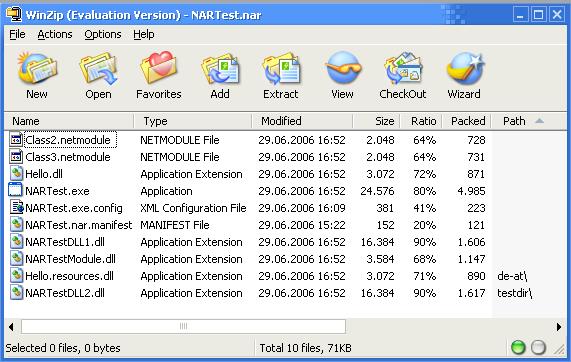
Introduction
Maybe, some of you know the concept of JAR archives from Java. A lot of things from Java have found their way to the .NET world. Having the same functionality for .NET would be a nice feature. Since .NET 2, Microsoft has included some very interesting features in the CLR and the framework. These features make it possible to create the functionality needed to handle archives for .NET - called NAR archives. NAR archives are ordinary ZIP files containing an (optional) XML manifest file - which informs the loader about what to load, and all application contents like the app.config file and the assemblies. The loader for these archives works only with .NET 2.x. .NET 1.x is not supported.
So today, we have XCOPY deployment of .NET applications, but tomorrow, we might have single file copy deployment for .NET applications.
Background
The CLR as the heart of .NET is a standard Windows component, and as such, it can be used by other (unmanaged) Windows applications to extend them with .NET functionality. This is also true for .NET 1.x. But since .NET 2.0, you can customize a lot more things when using the CLR. From telling the CLR from where to load assemblies (that's one thing that's used by the NAR loader), to how the GC should behave, or what to do with policies. By hosting the CLR in an application, you can extend it, but unfortunately, the way to achieve this is not always as straightforward as it could be. Especially, security can be tricky. The loader creates its own CAS group during installation. You can examine this group with the Microsoft .NET Framework 2.0 Configuration Control Panel applet (Control Panel/Administrative Tools/Microsoft .NET Framework 2.0 Configuration).
Using the code
The NAR loader consists of three parts:
- The unmanaged VC++ host for the CLR.
The host is responsible for preparing the right conditions for the following managed part. It ensures that security is in place, configures the CLR, provides the assemblies of the NAR archive to the CLR, and after the application inside the NAR archives terminates, cleans up everything. This part also registers the file extension .nar with the NAR loader so that a double-click is enough to start applications from inside NAR archives.
- The managed C# domain manager.
The assembly of the managed domain manager is included as a resource in the unmanaged host part of the loader. After the unmanaged part has finished initialization and setup, the assembly is extracted from the resource and loaded into the CLR. This is done in memory without extracting it to the disk first!
- A sample NAR archive with a test application which tests most aspects of .NET applications like satellite assemblies, private search paths, multi module assemblies etc.
You will find Debug and Release builds zipped in the bin directory. Building the loader from source builds all three parts. A build should normally work without problems, but if it fails, it's likely that one of the custom build steps needs customization (Projects: NARTestModule, NARTest, NARLoaderManager, NARLoaderMain, and the file NARLoader.h in NARLoaderMain).
New features
This version of the loader is now capable of creating self running archives, including the possibility to use custom icons for the resulting
.exe file. Now, you can pack your application's assemblies into one single
.exe file and deploy this. Password protected, strong AES encrypted archives are now also possible. Use this feature to either obfuscate your applications assemblies and/or to control application usage.
If your archive contains a zip comment this can be displayed at application startup. It can be used to display license agreements or other information.
Points of interest
Hosting the CLR is a great way to extend unmanaged applications, but it is also an opportunity to extend the .NET environment itself. Using the CLR hosting interfaces is (most of the time) straightforward, but sometimes the available documentation on MSDN lacks some clarifying hints. During development, fuslogvw.exe was a valuable tool for debugging. By using NAR archives, application deployment can be simplified.
A full manual and further information about the NAR loader can be found at the NAR loader project website.
History
The latest stable version is 1.2 as of 26 October 2006.
Current version
| 1.2 | 2006.10.26 | Adds support for strong AES encrypted, password protected archives and archive comments |
Older versions
| 1.1 | 2006.08.17 | Adds support for self-running archives including custom icons |
| 1.0a | 2006.08.03 | Allows install and uninstall of loader CAS code group, and .nar file extension handling. |
| 1.0 | 2005.03.03 | First public release - no longer available |
